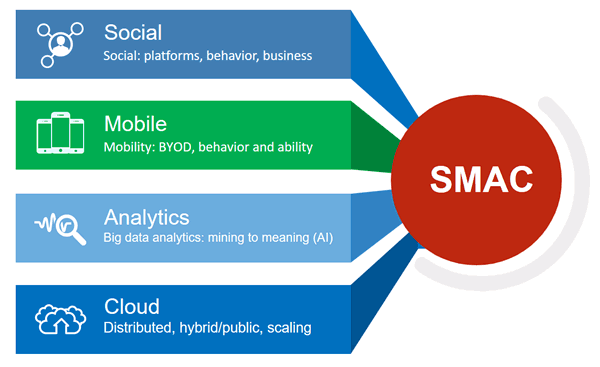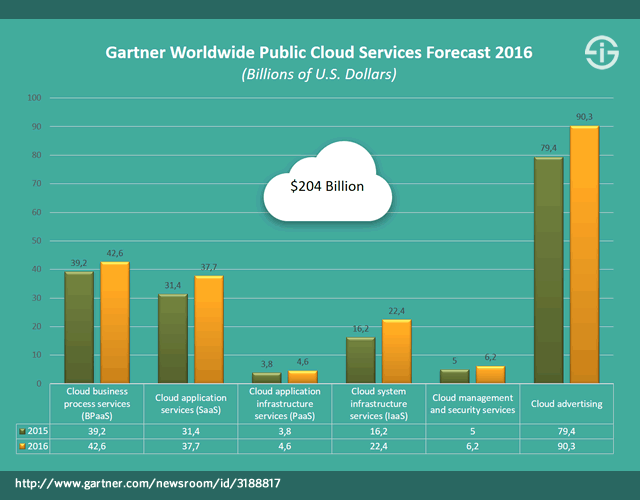The cloud delivery model has been heralded as the game changer of IT’s business model and even the very essence of business transformation in a digital age for many years. Cloud computing or ‘the cloud’ takes center stage in the technological evolutions that have led us to the current waves of accelerated innovation and optimization such as digital transformation and Industry 4.0.
“Cloud First” will become the new mantra for enterprise IT (IDC)
Despite the huge role of the cloud in a myriad of changes regarding the ways we work, use applications, organize IT and so much more, in the end the adoption of cloud services has taken relatively long and a really mature approach regarding the cloud is still often absent. As you’ll read organizations are investing more in strategies to get the most of their cloud investments for many years to come as the cloud remains key to digital transformation.

The popularity and success of the cloud: how we – slowly – got there
Imagine: we’ve been using the ASP model (Application Service Provider, not the same as the cloud) for software since the second half of the nineties for a growing number of applications and moved from the similar experience of that ASP model to the cloud with SaaS (Software as a Service) only a few years later. The cloud started gaining rapid attention around the end of the previous Millennium and beginning of the new one.
Virtually everyone in the industry expected 2010-2011 to be the year(s) where cloud adoption would really explode but for many reasons it didn’t. It’s around that time that the narrative starting changing: away from selling the cloud model as such to making the usage cases for cloud computing tangible and clear across all its layers and in numerous real-life cases. It was the end of the hype, even if some still see the cloud as a hype. But as you’ll read things really started changing in 2014-2015 and expectations are huge – for multiple reasons.
So, all in all, it took the cloud over one and a half decade to start going mainstream, even if there are still several challenges, not in the least on the strategic level. In these days that’s a long time but it’s clear that in the meantime the cloud, one of the pillars of the 3rd platform, transformed the very business model of IT and has enabled organizations to transform their business models and processes faster and at larger scale.

The cloud is many things: shifting from traditional benefits to tangible value and transformation
However, as said if we look at the cloud delivery model and at cloud services overall (private, public, hybrid cloud; SaaS, IaaS, PaaS etc.) we still see relatively limited adoption in some areas and often also see popping up the same questions and debates we already had in the previous decade.
While some of these debates are certainly important (think security, for instance), discussions about the benefits of one cloud approach over another are becoming archaic. The fact is that we talked far too long about the cloud as a thing and started describing its benefits and challenges, as well as those of the various models: public, private, hybrid, the list goes on.
The reality of an organization doesn’t revolve around this and in a sense we shouldn’t use the term the cloud alltogether as it strengthens the impression of a thing, rather than the complexity and variety of cloud services, deployments and strategies in a world where each business is different.
Another reality we now and then forget is that almost all businesses today use one or more forms of the cloud. It’s just not always happening through IT and seldom in a strategic and coordinated way.
At the same thing something is changing when it boils down to the cloud. In the early years the focus was a lot on ad hoc deployments for specific business purposes and on mixed approaches, enabling organizations to test the waters with not too many risks.
The benefits of the cloud were mainly sold from a rather traditional perspective of costs (OPEX instead of CAPEX), rapid deployment, independence from IT in the SaaS field and here and there (business) agility.
Today that picture is changing. While traditional benefits keep being mentioned, organizations look at the cloud as a way to innovate, develop value, increase speed of business and all those other aspects we typically associate with digital transformation. However, the gaps regarding maturity and the lack of an integrated approach towards the hybrid reality of various cloud deployments remain.
The need for flexibility and agility in the actual business processes today de facto is among the key drivers of the shift towards hybrid cloud models.
Where do we stand with the cloud? Towards cloud first
Cloud adoption keeps growing and after having missed several growth expectations again in 2014, 2015 was a turning point and for this year and the years beyond we see quick evolutions, accelerating growth/adoption and important shifts in what is moved to the cloud and how.
In 2015 an IDC survey indicated that 68% or organizations had some form of cloud strategy (public or private). Note the presence of the word strategy. It’s not that the other 32% of respondents don’t “use” the cloud one way or the other.
IDC also found that, quote, a very broad range of workloads are migrating to the cloud. 30 percent of organizatons had already migrated or planned to migrate every workload IDC asked respondents about to the cloud. Still, the challenge remained: most organizations continue to work on improving their cloud strategies as more of them live in multi-cloud realities.
When announcing its views on a nascent DX or digital transformation economy in its IT predictions for 2016 and beyond, IDC stated that “Cloud First” would become the new mantra for enterprise IT as no major digital transformation initiatives are possible in scaled-up implementations without the cloud as the foundation. IDC added bullish predictions, saying that the overal enterprise spending on cloud services (hardware, software, implementation services etc.) “will exceed $500 billion, more than three times what it is today”.
We see similar predictions elsewhere. Moreover, it’s not just about the dramatic shifts in how organizations invest more in the cloud. What we see is that the type of services which move to the cloud are more mission-critical. Furthermore, the public cloud services market is growing fast.
Gartner, for instance, found that IaaS (Infrastructure as a Service), is the fastest growing segment in 2016, even if it’s not the biggest (the top two in size consists of cloud business process services or BPaaS and good old SaaS).

Explaining the fact that IaaS is the fastest growing segment, Gartner research director Sid Nag points to the shift away from data center build-outs and moving away of infrastructure needs to the public cloud.
When looking at the move to the public cloud he says: “This strong growth continues reflect a shift away from legacy IT services to cloud-based services, due to increased trend of organizations pursuing a digital business strategy.”
Although it is expected that the discussions regarding cloud deployment types (public, private,…) are over – for now – it’s interesting to see the state of cloud infrastructure investment (servers, enterprise storage, and Ethernet switches) in a cloud adoption reality that is clearly hybrid.
IDC, which found a slowdown in the first quarter of 2016, released its updated Worldwide Quarterly Cloud IT Infrastructure Tracker early July 2016, showing a:
- 4.4 percent decline in traditional, non-cloud environments.
- 10.3 percent growth of private cloud IT infrastructure investments in 2016, with the majority being on-premises private cloud environments.
- 18.8 percent increase in spending on public cloud IT infrastructure.
Hybrid cloud and cloud brokerage
As mentioned there are several evolutions and shifts in the approach regarding cloud computing and strategies to gain a more integrated and strategic approach in a hybrid cloud reality.
With that hybrid cloud reality we don’t even necessarily mean the hybrid cloud delivery model as such but first and foremost the fact that organizations are looking for solutions to manage their overall hybrid realities in which multiple cloud deployments, models and services are mixed.
These strategies are, among others, driven by the clear need for a more mature cloud approach where control, flexibility and choice meet the demands for the cloud as an enabler of digital transformation and optimization strategies.
This is one of the reasons that on top of the de facto reality of the hybrid cloud delivery model there is a growing vendor focus on a bloud brokerage approach, even if that is a very complex approach that requires at least as much consulting as it is about connecting various clouds and resources and making them easier to manage and control using a management platform.
Top image: Shutterstock – Copyright: Melpomene

